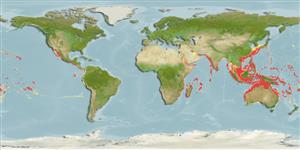Common names from other countries
Lớp phụ Cá sụn (cá mập và cá đuối) (sharks and rays) >
Myliobatiformes (Stingrays) >
Dasyatidae (Stingrays) > Dasyatinae
Etymology: Taeniurops: From feminine Latin noun, 'taenia' = ribbon or band, ancient Greek 'oura' = tail, referring to fin fold underneath tail and Greek 'ops' = appearance; originally proposed as a subgenus of Taeniura (Richard Bajol, pers. Comm. 06/16)..; meyeni: Named for Franz Julius Ferdinand Meyen (1804-1840), physician and botanist (R. Bajol, pers.comm. 06/16)..
More on authors: Müller & Henle.
Issue
same spelling in 3263
Environment: milieu / climate zone / depth range / distribution range
Sinh thái học
Biển Cùng sống ở rạn san hô; Mức độ sâu 1 - 500 m (Ref. 37816), usually 20 - 60 m (Ref. 30573). Tropical; 41°N - 36°S, 25°E - 77°W
Indo-West Pacific: Persian Gulf (Ref. 68964), Red Sea and East Africa to southern Japan, Micronesia, tropical Australia and Lord Howe Island. Eastern Pacific: known only from oceanic islands (Cocos and the Galapagos) but because of sheer number, individuals may colonize the Central America mainland (Ref. 28023). More widely known as Taeniura melanospila Bleeker 1853, a junior synonym based on the description of a juvenile specimen.
Length at first maturity / Bộ gần gũi / Khối lượng (Trọng lượng) / Age
Maturity: Lm 105.0, range 100 - 110 cm
Max length : 330 cm TL con đực/không giới tính; (Ref. 30573); Khối lượng cực đại được công bố: 150.0 kg (Ref. 11228)
A large stingray with a circular disc, no thorns, a black and white mottled upper surface, and a deep and prominent ventral skin fold that extends to the tail tip (Ref. 6871).
Occurs in a wide range of habitats, from shallow lagoons to outer reef slopes (Ref. 1602). Feeds on bottom fish, bivalves, crabs and shrimp (Ref. 5578). Ovoviviparous (Ref. 50449). Smallest free-swimming specimen recorded was 33 cm WD. Caught commonly by demersal tangle net fisheries, and occasionally by longline and bottom trawl fisheries. Utilized for its meat and cartilage (Ref.58048). Found singly or in aggregates and usually with jacks and cobia swimming near them (Ref. 12951). Not normally aggressive, but it has been responsible for at least one human fatality. Sought by surf and ski boat anglers in southern Africa, but usually released unharmed (Ref. 5578). Longevity record for a specimen in an aquarium is 81 days (Ref. 12951). May reach disc width in excess of 3 m (Ref. 28023).
Exhibit ovoviparity (aplacental viviparity), with embryos feeding initially on yolk, then receiving additional nourishment from the mother by indirect absorption of uterine fluid enriched with mucus, fat or protein through specialised structures (Ref. 50449). Distinct pairing with embrace (Ref. 205). With up to 7 in a litter (Ref. 6871, 12951).
Last, P.R. and J.D. Stevens, 1994. Sharks and rays of Australia. CSIRO, Australia. 513 p. (Ref. 6871)
IUCN Red List Status (Ref. 130435)
CITES (Ref. 128078)
Not Evaluated
Human uses
Các nghề cá: Tính thương mại; cá để chơi: đúng
Các công cụ
Special reports
Download XML
Các nguồn internet
Estimates based on models
Preferred temperature (Ref.
115969): 23.3 - 29.1, mean 28 (based on 1102 cells).
Phylogenetic diversity index (Ref.
82804): PD
50 = 1.0000 [Uniqueness, from 0.5 = low to 2.0 = high].
Bayesian length-weight: a=0.00646 (0.00265 - 0.01571), b=3.06 (2.86 - 3.26), in cm Total Length, based on LWR estimates for this (Sub)family-body shape (Ref.
93245).
Mức dinh dưỡng (Ref.
69278): 4.2 ±0.69 se; based on food items.
Thích nghi nhanh (Ref.
120179): Rất thấp, thời gian nhân đôi của chủng quần tối thiểu là hơn 14 năm (Fec=7).
Fishing Vulnerability (Ref.
59153): Very high vulnerability (90 of 100).
